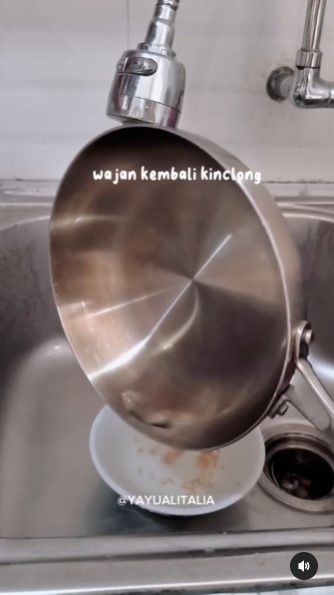Instagram/@yayualitalia
Brilio.net - There are various types of Teflon that can be used for cooking. Starting from Teflon granite, non-stick, to stainless steel. Any type of Teflon used has the risk of making the cooking ingredients stick to the bottom, especially if the dish requires minimal water and oil, such as a stir fry.
If cleaned quickly, cooking stains on the Teflon base tend to disappear more easily. In contrast, if the stain has been left for a long time, it might turn into a stubborn crust on the bottom of the Teflon. This is also often experienced by netizens on the Instagram account @yayualitalia.
He admitted that in the past he often had difficulty cleaning the scale stains on the Teflon base . Before knowing this trick, he always had a hard time scrubbing the Teflon base with a sponge or wire wool for a long time so that the crust stains disappeared. However, now you only need three kitchen ingredients, the Teflon base can be cleaned easily.
"This tip is used for those who need a quick way to clean without using veins for stubborn crust stains or burnt marks," he wrote in an Instagram upload @yayualitalia, quoted by BrilioFood on Thursday (7/3).
How to clean scale stains on Teflon base.
The kitchen ingredients that need to be prepared are baking soda and vinegar. Immediately place the two materials onto the Teflon base area . After that, heat the Teflon over medium heat. Yup, the trick for cleaning crust stains on the bottom of Teflon requires going through the heating process on a stove fire.

photo: Instagram/@yayualitalia
After that, prepare one more kitchen ingredient, namely lemon slices. Use this fruit to rub baking soda and vinegar on the bottom of the Teflon so that the stubborn crust stains can come off. When the vinegar and baking soda mixture boils, turn off the heat on the stove. Continue the process of rubbing the lemon for a few moments until all the crust stains are no longer stubborn.

photo: Instagram/@yayualitalia
Finally, the netizen who is familiarly called Yayu said, if all the stains are gone, then rinse the Teflon with running water. Look, Yayu's Teflon which was originally full of stubborn crust can become shiny again after washing it with this trick, right?

photo: Instagram/@yayualitalia
So, even without scrubbing with a sponge, you can still make Teflon shine with this Yayu-style trick for cleaning limescale stains, right? Taking a peek at @yayualitalia's Instagram upload which has been watched 1 million times, quite a few netizens have left enthusiastic comments, you know. On the other hand, there are also those who share other tricks.
"After cooking, when the pan is still hot, immediately pour water on it to let it cool, then wash it thoroughly," wrote Instagram @noelsweet87.
"Sis, just fill it with water and then heat it and it will pop out, emanate the lemon," said Instagram @devap90.
"There's a way to make sure it doesn't stick, it's called priming, rub oil on the pan, heat it on the stove until it's evenly distributed over all surfaces of the pan, lift it and then rinse it with water, repeat the process three times in a row before cooking, it definitely won't stick anymore: "For the oil, it doesn't have to be new oil, just use used oil, that's okay, if it's been primed, just use new oil," explained Instagram @ardnacmor.
View this post on Instagram
How to store cut lemons.
Lemons have quite a sour taste, so you don't have to use a whole fruit for cooking. So, don't throw away the remaining lemon slices that haven't been used straight away, okay? Here are some ways to store cut lemons to keep them fresh and last longer.
1. Store in an airtight container.
Store lemon slices in an airtight container or ziplock bag to prevent air from entering and reducing the humidity level around them.
2. Wrap with plastic wrap.
Wrap the lemon slices in plastic wrap or aluminum foil to protect them from air and excess moisture.
3. Refrigeration.
Store lemon slices in the refrigerator to maintain freshness. Lemons can last longer in cooler temperatures.
4. Don't leave any skin.
If possible, cut off the zest from the lemon before storing. Lemon peel tends to make lemon slices go bad more quickly.
5. Pay attention to the condition of the piece.
Make sure there are no rotten or moldy parts on the lemon slices before storing. Contaminated cuts can accelerate the deterioration of other lemons.
6. Use for a short time.
Try to use the lemon slices for a short time to keep them fresh. Even with good storage, lemon slices will still degrade over time.
(brl/lut)